An Analysis of Line Managers' Role in Performance Appraisal
VerifiedAdded on 2019/12/17
|27
|6284
|644
Report
AI Summary
This report comprehensively examines the role of line managers in performance appraisal, beginning with an abstract that highlights the significance of strategic HRM and the influence of line managers on employee commitment. It explores performance appraisal theories, including social exchange theory, self-efficacy theory, and goal theory, and details various appraisal methods such as numerical rating scales, objective-based appraisals, 360-degree appraisals, and critical incidents. The report further discusses the advantages and disadvantages of performance appraisals, the specific responsibilities of line managers in HRM, and the challenges they face. It delves into strategic HRM, devolution to line management, and concludes with a discussion of key findings and practical implications, providing a thorough analysis of the subject.
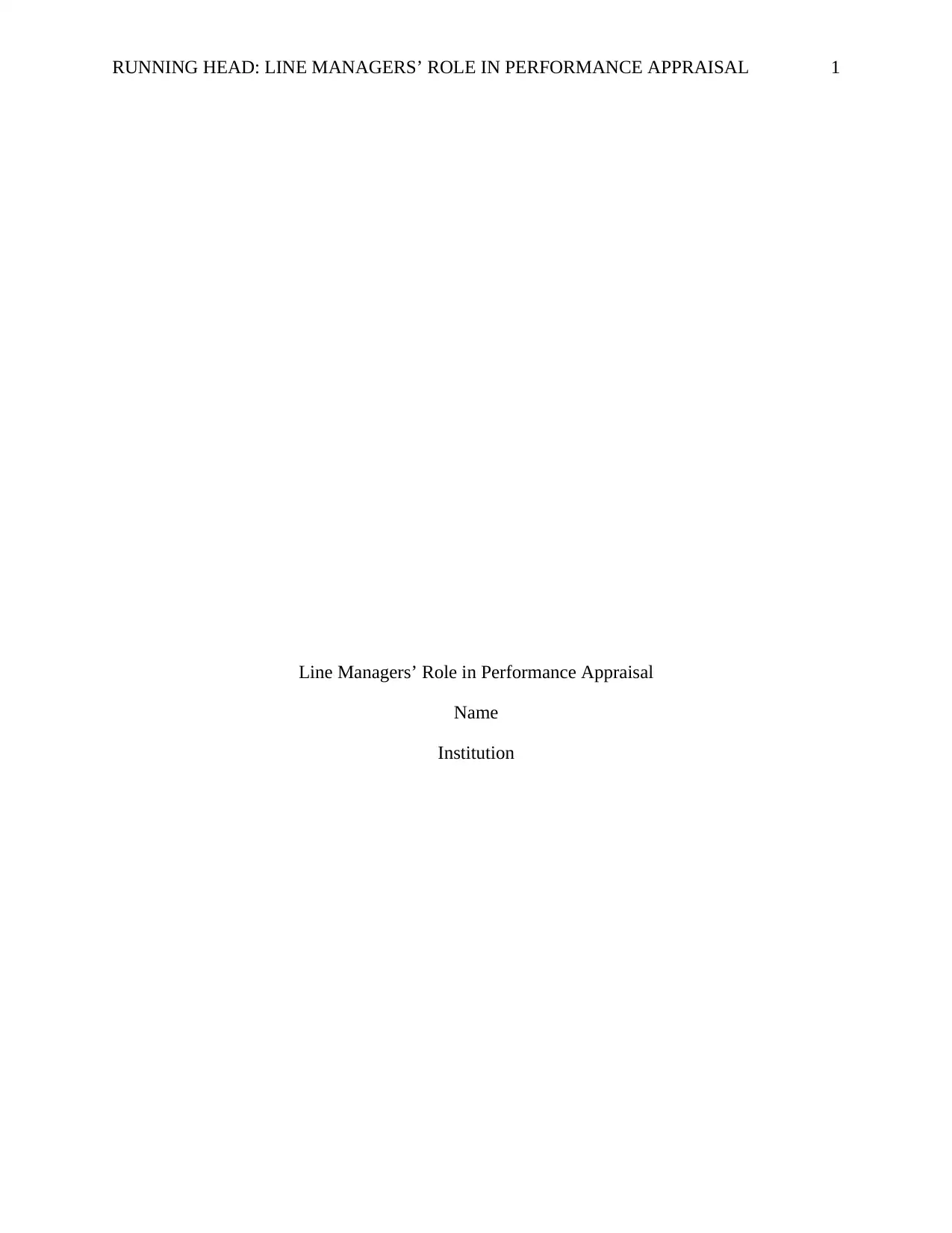
RUNNING HEAD: LINE MANAGERS’ ROLE IN PERFORMANCE APPRAISAL 1
Line Managers’ Role in Performance Appraisal
Name
Institution
Line Managers’ Role in Performance Appraisal
Name
Institution
Paraphrase This Document
Need a fresh take? Get an instant paraphrase of this document with our AI Paraphraser
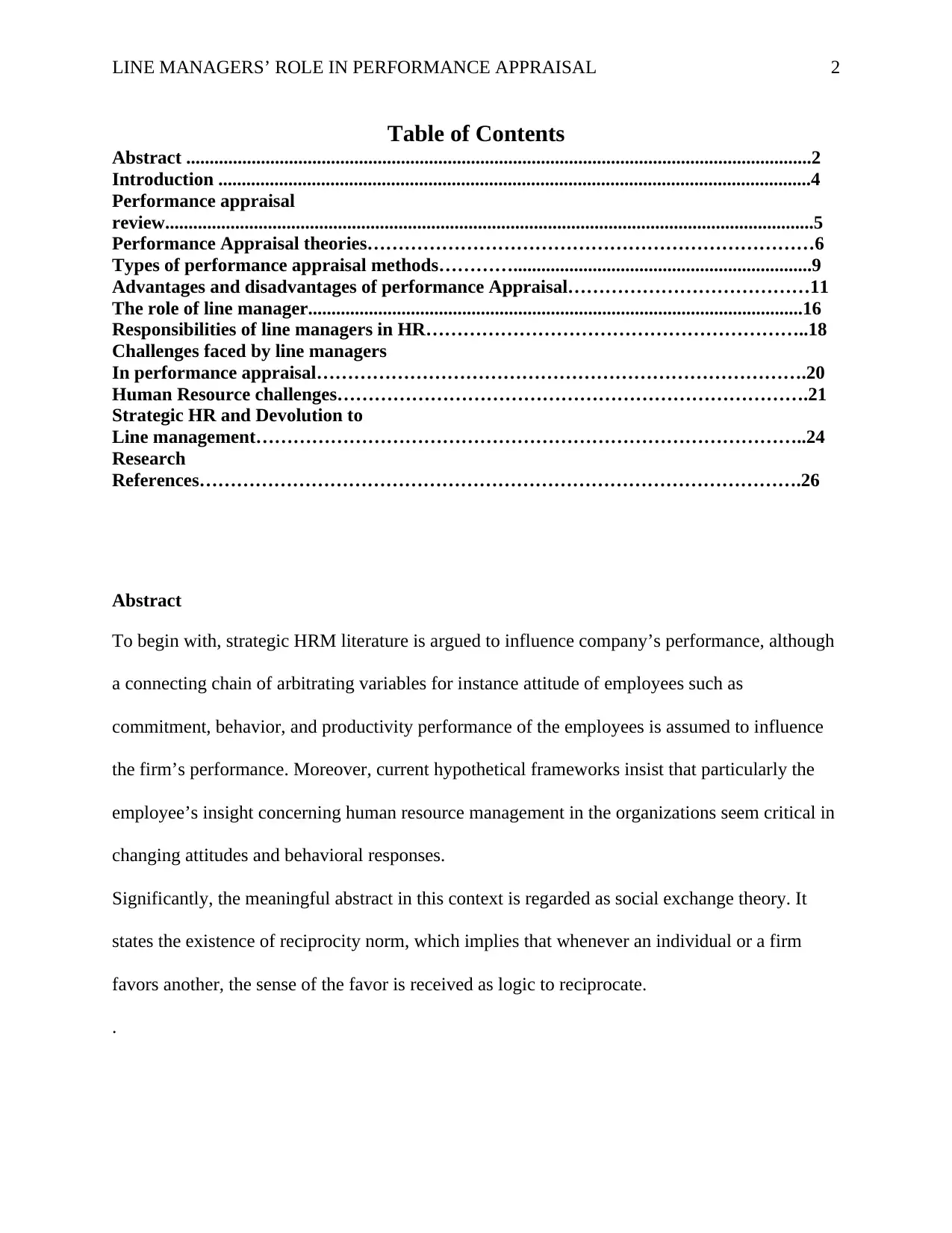
LINE MANAGERS’ ROLE IN PERFORMANCE APPRAISAL 2
Table of Contents
Abstract ......................................................................................................................................2
Introduction ...............................................................................................................................4
Performance appraisal
review...........................................................................................................................................5
Performance Appraisal theories………………………………………………………………6
Types of performance appraisal methods…………................................................................9
Advantages and disadvantages of performance Appraisal…………………………………11
The role of line manager..........................................................................................................16
Responsibilities of line managers in HR……………………………………………………..18
Challenges faced by line managers
In performance appraisal…………………………………………………………………….20
Human Resource challenges………………………………………………………………….21
Strategic HR and Devolution to
Line management……………………………………………………………………………..24
Research
References…………………………………………………………………………………….26
Abstract
To begin with, strategic HRM literature is argued to influence company’s performance, although
a connecting chain of arbitrating variables for instance attitude of employees such as
commitment, behavior, and productivity performance of the employees is assumed to influence
the firm’s performance. Moreover, current hypothetical frameworks insist that particularly the
employee’s insight concerning human resource management in the organizations seem critical in
changing attitudes and behavioral responses.
Significantly, the meaningful abstract in this context is regarded as social exchange theory. It
states the existence of reciprocity norm, which implies that whenever an individual or a firm
favors another, the sense of the favor is received as logic to reciprocate.
.
Table of Contents
Abstract ......................................................................................................................................2
Introduction ...............................................................................................................................4
Performance appraisal
review...........................................................................................................................................5
Performance Appraisal theories………………………………………………………………6
Types of performance appraisal methods…………................................................................9
Advantages and disadvantages of performance Appraisal…………………………………11
The role of line manager..........................................................................................................16
Responsibilities of line managers in HR……………………………………………………..18
Challenges faced by line managers
In performance appraisal…………………………………………………………………….20
Human Resource challenges………………………………………………………………….21
Strategic HR and Devolution to
Line management……………………………………………………………………………..24
Research
References…………………………………………………………………………………….26
Abstract
To begin with, strategic HRM literature is argued to influence company’s performance, although
a connecting chain of arbitrating variables for instance attitude of employees such as
commitment, behavior, and productivity performance of the employees is assumed to influence
the firm’s performance. Moreover, current hypothetical frameworks insist that particularly the
employee’s insight concerning human resource management in the organizations seem critical in
changing attitudes and behavioral responses.
Significantly, the meaningful abstract in this context is regarded as social exchange theory. It
states the existence of reciprocity norm, which implies that whenever an individual or a firm
favors another, the sense of the favor is received as logic to reciprocate.
.
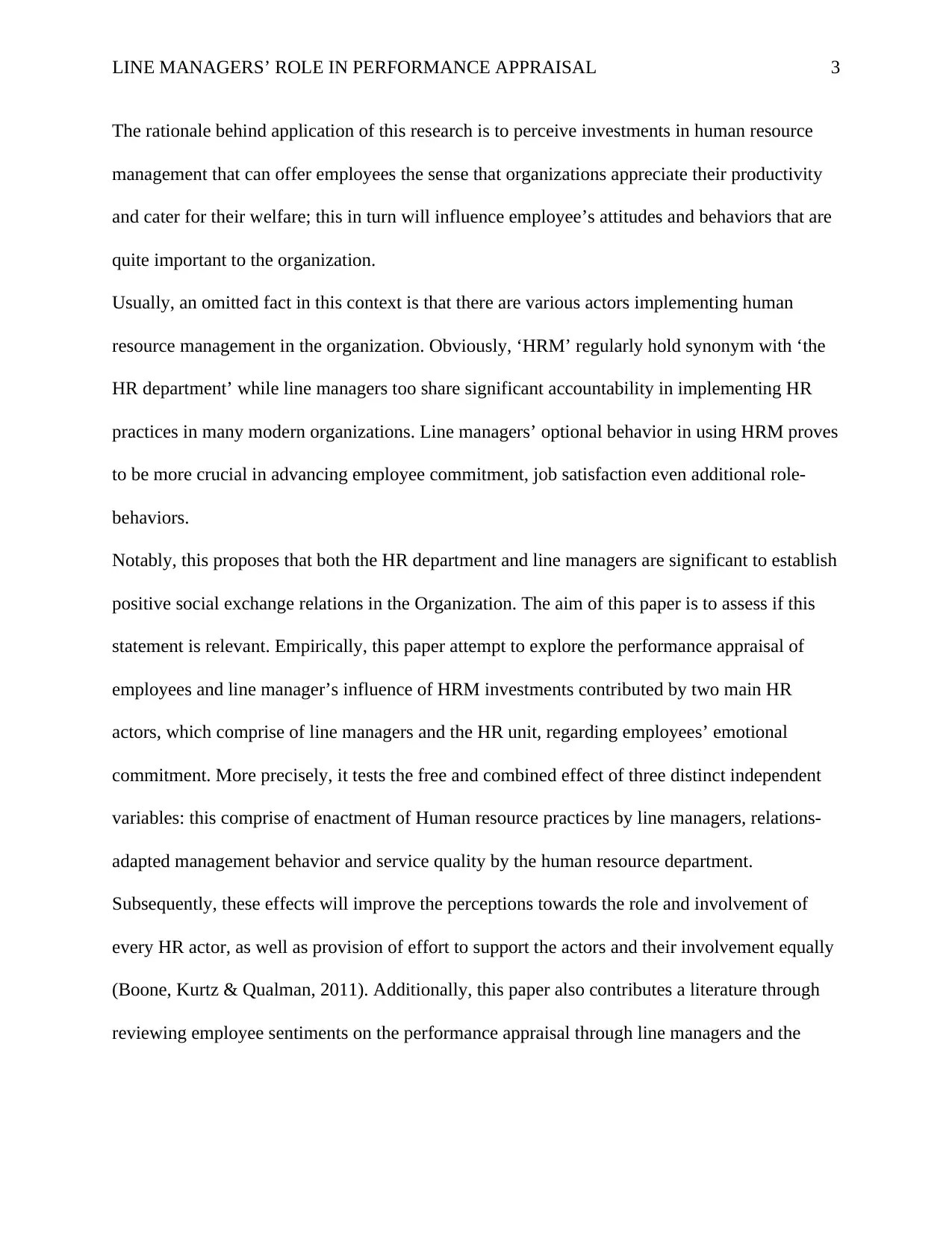
LINE MANAGERS’ ROLE IN PERFORMANCE APPRAISAL 3
The rationale behind application of this research is to perceive investments in human resource
management that can offer employees the sense that organizations appreciate their productivity
and cater for their welfare; this in turn will influence employee’s attitudes and behaviors that are
quite important to the organization.
Usually, an omitted fact in this context is that there are various actors implementing human
resource management in the organization. Obviously, ‘HRM’ regularly hold synonym with ‘the
HR department’ while line managers too share significant accountability in implementing HR
practices in many modern organizations. Line managers’ optional behavior in using HRM proves
to be more crucial in advancing employee commitment, job satisfaction even additional role-
behaviors.
Notably, this proposes that both the HR department and line managers are significant to establish
positive social exchange relations in the Organization. The aim of this paper is to assess if this
statement is relevant. Empirically, this paper attempt to explore the performance appraisal of
employees and line manager’s influence of HRM investments contributed by two main HR
actors, which comprise of line managers and the HR unit, regarding employees’ emotional
commitment. More precisely, it tests the free and combined effect of three distinct independent
variables: this comprise of enactment of Human resource practices by line managers, relations-
adapted management behavior and service quality by the human resource department.
Subsequently, these effects will improve the perceptions towards the role and involvement of
every HR actor, as well as provision of effort to support the actors and their involvement equally
(Boone, Kurtz & Qualman, 2011). Additionally, this paper also contributes a literature through
reviewing employee sentiments on the performance appraisal through line managers and the
The rationale behind application of this research is to perceive investments in human resource
management that can offer employees the sense that organizations appreciate their productivity
and cater for their welfare; this in turn will influence employee’s attitudes and behaviors that are
quite important to the organization.
Usually, an omitted fact in this context is that there are various actors implementing human
resource management in the organization. Obviously, ‘HRM’ regularly hold synonym with ‘the
HR department’ while line managers too share significant accountability in implementing HR
practices in many modern organizations. Line managers’ optional behavior in using HRM proves
to be more crucial in advancing employee commitment, job satisfaction even additional role-
behaviors.
Notably, this proposes that both the HR department and line managers are significant to establish
positive social exchange relations in the Organization. The aim of this paper is to assess if this
statement is relevant. Empirically, this paper attempt to explore the performance appraisal of
employees and line manager’s influence of HRM investments contributed by two main HR
actors, which comprise of line managers and the HR unit, regarding employees’ emotional
commitment. More precisely, it tests the free and combined effect of three distinct independent
variables: this comprise of enactment of Human resource practices by line managers, relations-
adapted management behavior and service quality by the human resource department.
Subsequently, these effects will improve the perceptions towards the role and involvement of
every HR actor, as well as provision of effort to support the actors and their involvement equally
(Boone, Kurtz & Qualman, 2011). Additionally, this paper also contributes a literature through
reviewing employee sentiments on the performance appraisal through line managers and the
⊘ This is a preview!⊘
Do you want full access?
Subscribe today to unlock all pages.

Trusted by 1+ million students worldwide
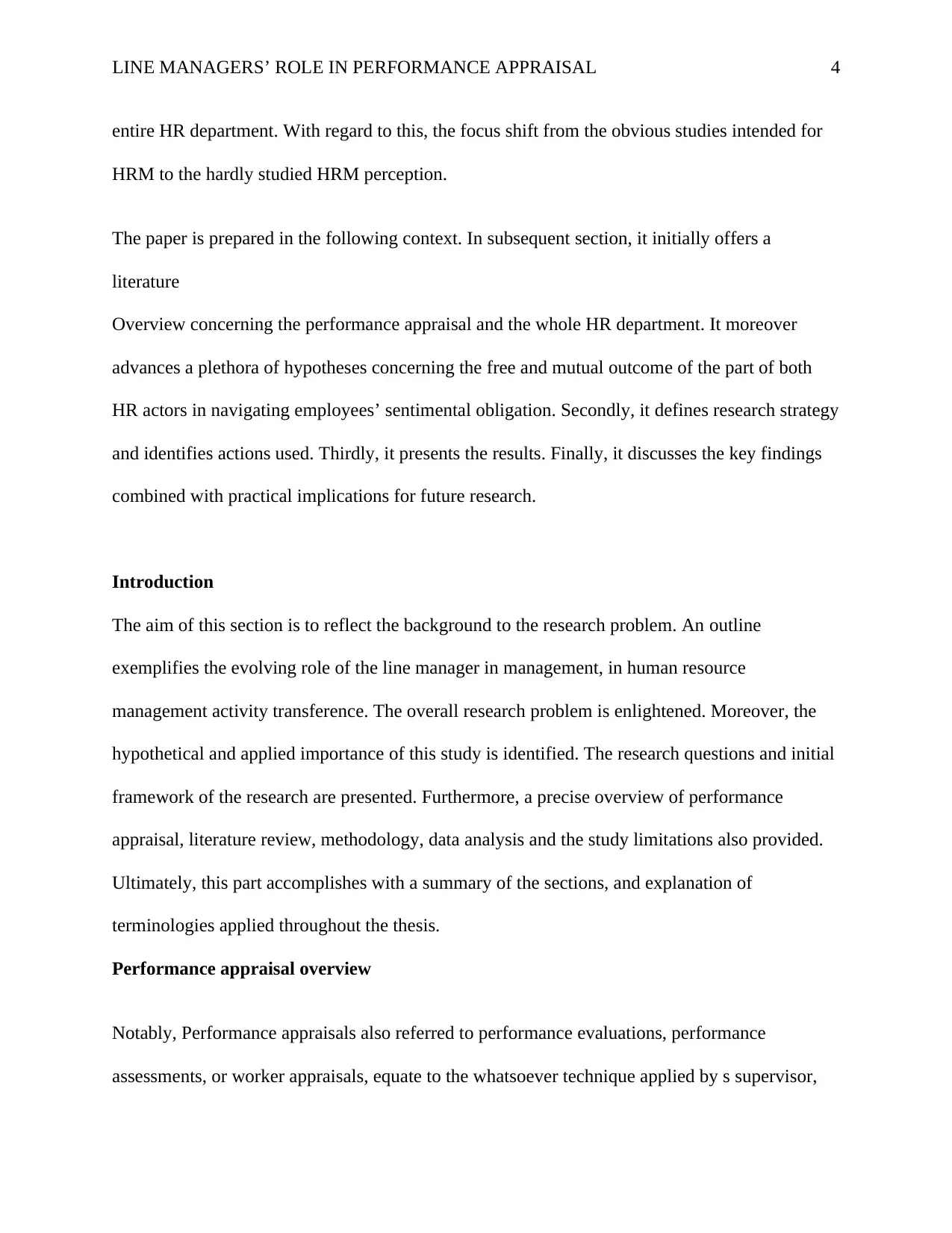
LINE MANAGERS’ ROLE IN PERFORMANCE APPRAISAL 4
entire HR department. With regard to this, the focus shift from the obvious studies intended for
HRM to the hardly studied HRM perception.
The paper is prepared in the following context. In subsequent section, it initially offers a
literature
Overview concerning the performance appraisal and the whole HR department. It moreover
advances a plethora of hypotheses concerning the free and mutual outcome of the part of both
HR actors in navigating employees’ sentimental obligation. Secondly, it defines research strategy
and identifies actions used. Thirdly, it presents the results. Finally, it discusses the key findings
combined with practical implications for future research.
Introduction
The aim of this section is to reflect the background to the research problem. An outline
exemplifies the evolving role of the line manager in management, in human resource
management activity transference. The overall research problem is enlightened. Moreover, the
hypothetical and applied importance of this study is identified. The research questions and initial
framework of the research are presented. Furthermore, a precise overview of performance
appraisal, literature review, methodology, data analysis and the study limitations also provided.
Ultimately, this part accomplishes with a summary of the sections, and explanation of
terminologies applied throughout the thesis.
Performance appraisal overview
Notably, Performance appraisals also referred to performance evaluations, performance
assessments, or worker appraisals, equate to the whatsoever technique applied by s supervisor,
entire HR department. With regard to this, the focus shift from the obvious studies intended for
HRM to the hardly studied HRM perception.
The paper is prepared in the following context. In subsequent section, it initially offers a
literature
Overview concerning the performance appraisal and the whole HR department. It moreover
advances a plethora of hypotheses concerning the free and mutual outcome of the part of both
HR actors in navigating employees’ sentimental obligation. Secondly, it defines research strategy
and identifies actions used. Thirdly, it presents the results. Finally, it discusses the key findings
combined with practical implications for future research.
Introduction
The aim of this section is to reflect the background to the research problem. An outline
exemplifies the evolving role of the line manager in management, in human resource
management activity transference. The overall research problem is enlightened. Moreover, the
hypothetical and applied importance of this study is identified. The research questions and initial
framework of the research are presented. Furthermore, a precise overview of performance
appraisal, literature review, methodology, data analysis and the study limitations also provided.
Ultimately, this part accomplishes with a summary of the sections, and explanation of
terminologies applied throughout the thesis.
Performance appraisal overview
Notably, Performance appraisals also referred to performance evaluations, performance
assessments, or worker appraisals, equate to the whatsoever technique applied by s supervisor,
Paraphrase This Document
Need a fresh take? Get an instant paraphrase of this document with our AI Paraphraser
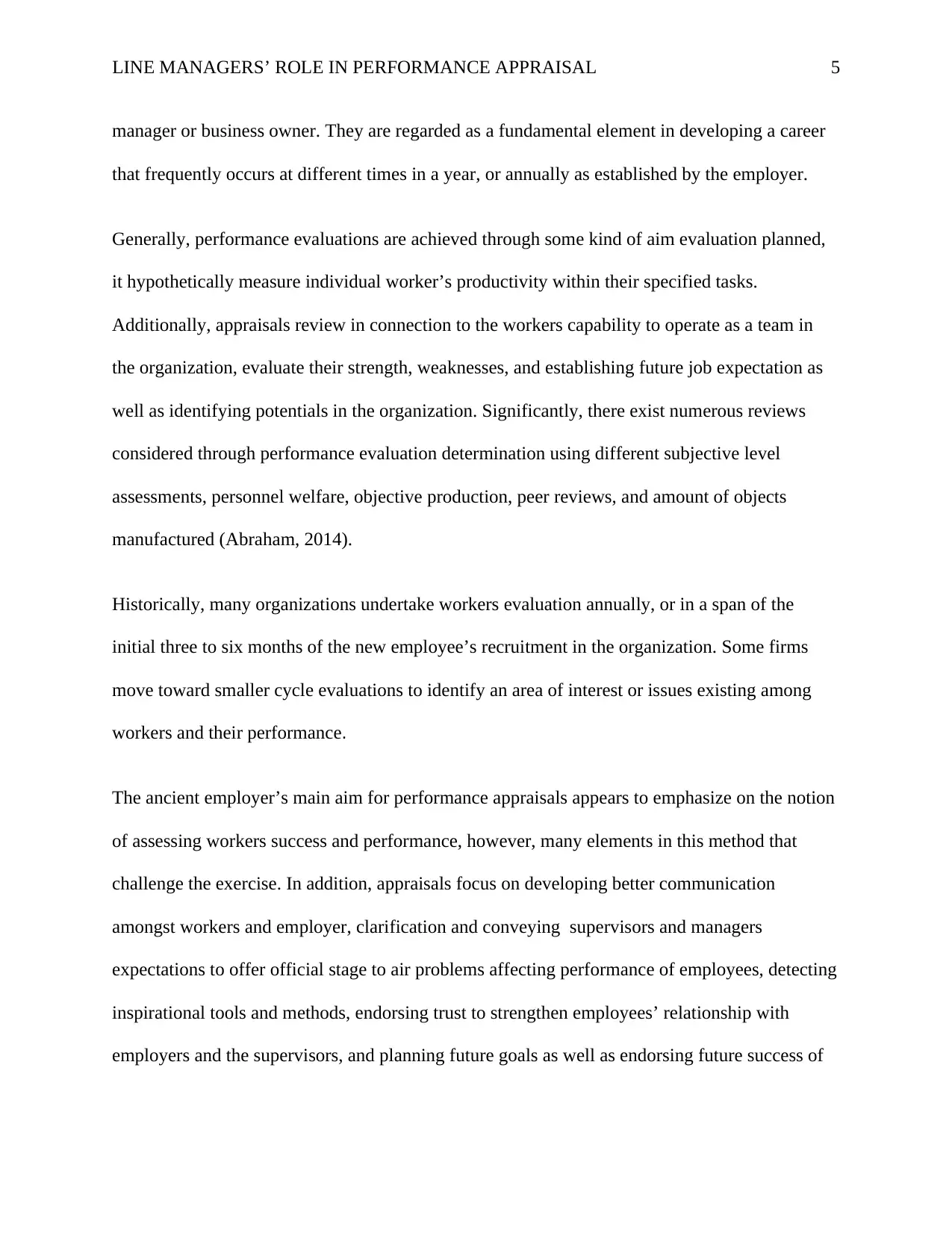
LINE MANAGERS’ ROLE IN PERFORMANCE APPRAISAL 5
manager or business owner. They are regarded as a fundamental element in developing a career
that frequently occurs at different times in a year, or annually as established by the employer.
Generally, performance evaluations are achieved through some kind of aim evaluation planned,
it hypothetically measure individual worker’s productivity within their specified tasks.
Additionally, appraisals review in connection to the workers capability to operate as a team in
the organization, evaluate their strength, weaknesses, and establishing future job expectation as
well as identifying potentials in the organization. Significantly, there exist numerous reviews
considered through performance evaluation determination using different subjective level
assessments, personnel welfare, objective production, peer reviews, and amount of objects
manufactured (Abraham, 2014).
Historically, many organizations undertake workers evaluation annually, or in a span of the
initial three to six months of the new employee’s recruitment in the organization. Some firms
move toward smaller cycle evaluations to identify an area of interest or issues existing among
workers and their performance.
The ancient employer’s main aim for performance appraisals appears to emphasize on the notion
of assessing workers success and performance, however, many elements in this method that
challenge the exercise. In addition, appraisals focus on developing better communication
amongst workers and employer, clarification and conveying supervisors and managers
expectations to offer official stage to air problems affecting performance of employees, detecting
inspirational tools and methods, endorsing trust to strengthen employees’ relationship with
employers and the supervisors, and planning future goals as well as endorsing future success of
manager or business owner. They are regarded as a fundamental element in developing a career
that frequently occurs at different times in a year, or annually as established by the employer.
Generally, performance evaluations are achieved through some kind of aim evaluation planned,
it hypothetically measure individual worker’s productivity within their specified tasks.
Additionally, appraisals review in connection to the workers capability to operate as a team in
the organization, evaluate their strength, weaknesses, and establishing future job expectation as
well as identifying potentials in the organization. Significantly, there exist numerous reviews
considered through performance evaluation determination using different subjective level
assessments, personnel welfare, objective production, peer reviews, and amount of objects
manufactured (Abraham, 2014).
Historically, many organizations undertake workers evaluation annually, or in a span of the
initial three to six months of the new employee’s recruitment in the organization. Some firms
move toward smaller cycle evaluations to identify an area of interest or issues existing among
workers and their performance.
The ancient employer’s main aim for performance appraisals appears to emphasize on the notion
of assessing workers success and performance, however, many elements in this method that
challenge the exercise. In addition, appraisals focus on developing better communication
amongst workers and employer, clarification and conveying supervisors and managers
expectations to offer official stage to air problems affecting performance of employees, detecting
inspirational tools and methods, endorsing trust to strengthen employees’ relationship with
employers and the supervisors, and planning future goals as well as endorsing future success of
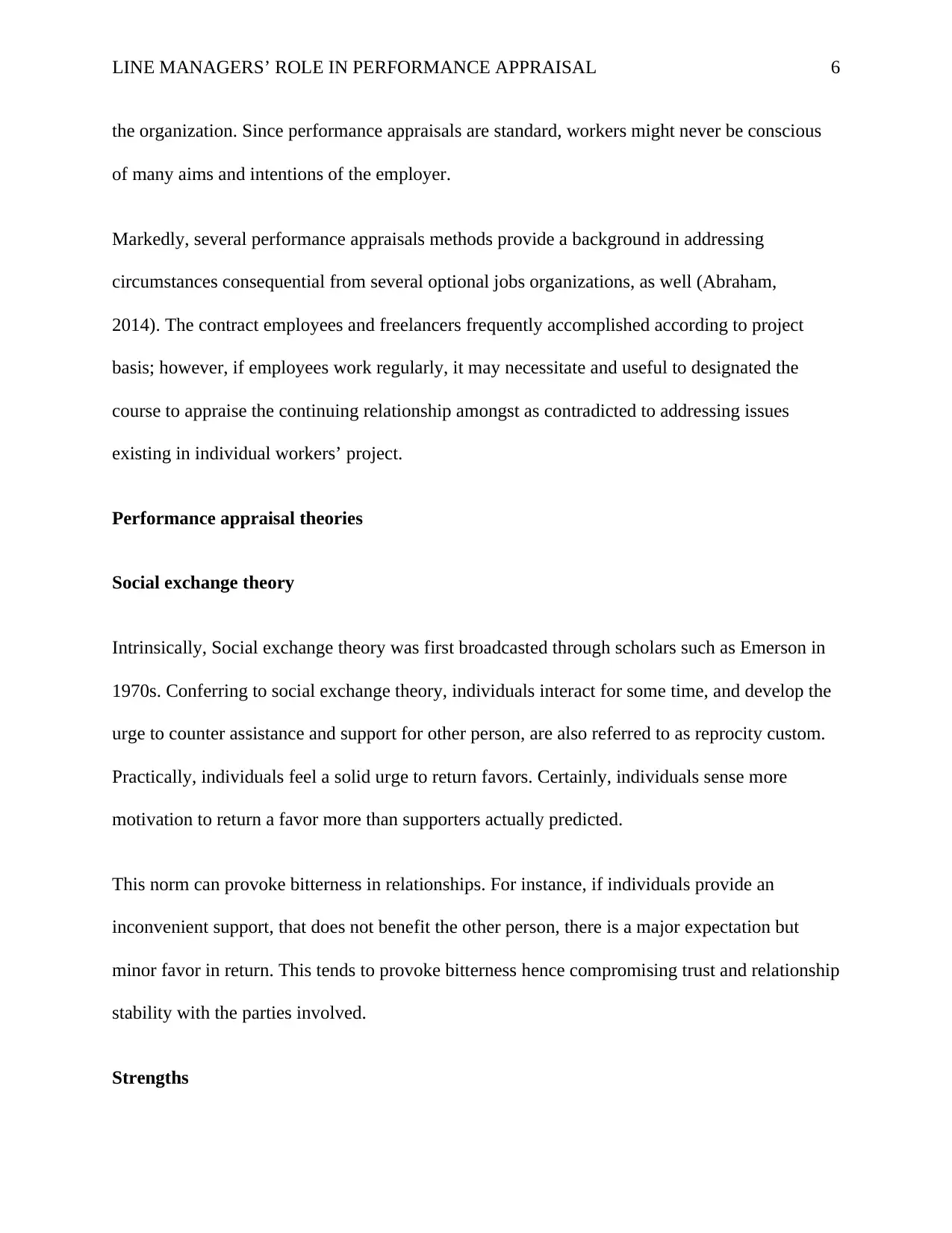
LINE MANAGERS’ ROLE IN PERFORMANCE APPRAISAL 6
the organization. Since performance appraisals are standard, workers might never be conscious
of many aims and intentions of the employer.
Markedly, several performance appraisals methods provide a background in addressing
circumstances consequential from several optional jobs organizations, as well (Abraham,
2014). The contract employees and freelancers frequently accomplished according to project
basis; however, if employees work regularly, it may necessitate and useful to designated the
course to appraise the continuing relationship amongst as contradicted to addressing issues
existing in individual workers’ project.
Performance appraisal theories
Social exchange theory
Intrinsically, Social exchange theory was first broadcasted through scholars such as Emerson in
1970s. Conferring to social exchange theory, individuals interact for some time, and develop the
urge to counter assistance and support for other person, are also referred to as reprocity custom.
Practically, individuals feel a solid urge to return favors. Certainly, individuals sense more
motivation to return a favor more than supporters actually predicted.
This norm can provoke bitterness in relationships. For instance, if individuals provide an
inconvenient support, that does not benefit the other person, there is a major expectation but
minor favor in return. This tends to provoke bitterness hence compromising trust and relationship
stability with the parties involved.
Strengths
the organization. Since performance appraisals are standard, workers might never be conscious
of many aims and intentions of the employer.
Markedly, several performance appraisals methods provide a background in addressing
circumstances consequential from several optional jobs organizations, as well (Abraham,
2014). The contract employees and freelancers frequently accomplished according to project
basis; however, if employees work regularly, it may necessitate and useful to designated the
course to appraise the continuing relationship amongst as contradicted to addressing issues
existing in individual workers’ project.
Performance appraisal theories
Social exchange theory
Intrinsically, Social exchange theory was first broadcasted through scholars such as Emerson in
1970s. Conferring to social exchange theory, individuals interact for some time, and develop the
urge to counter assistance and support for other person, are also referred to as reprocity custom.
Practically, individuals feel a solid urge to return favors. Certainly, individuals sense more
motivation to return a favor more than supporters actually predicted.
This norm can provoke bitterness in relationships. For instance, if individuals provide an
inconvenient support, that does not benefit the other person, there is a major expectation but
minor favor in return. This tends to provoke bitterness hence compromising trust and relationship
stability with the parties involved.
Strengths
⊘ This is a preview!⊘
Do you want full access?
Subscribe today to unlock all pages.

Trusted by 1+ million students worldwide
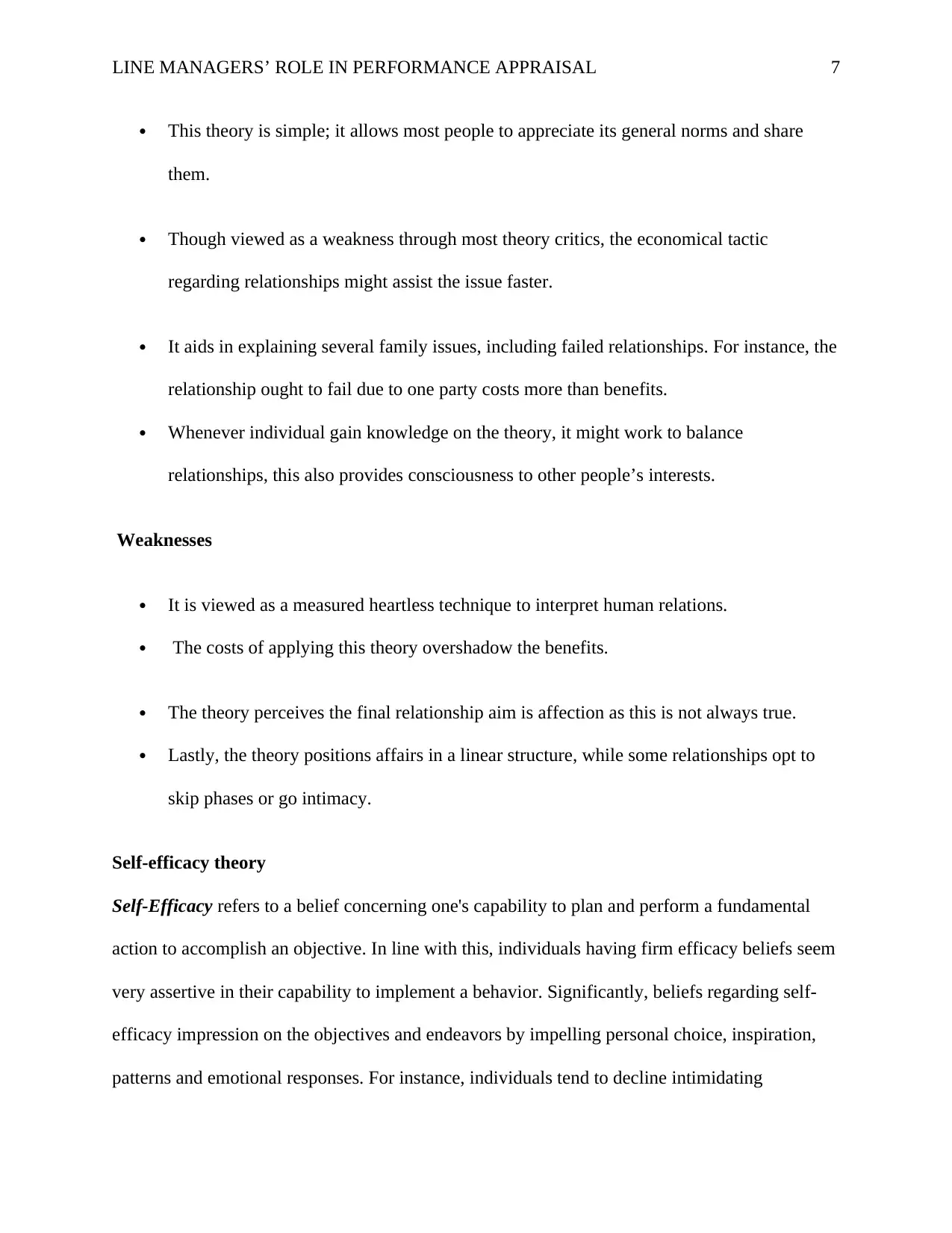
LINE MANAGERS’ ROLE IN PERFORMANCE APPRAISAL 7
This theory is simple; it allows most people to appreciate its general norms and share
them.
Though viewed as a weakness through most theory critics, the economical tactic
regarding relationships might assist the issue faster.
It aids in explaining several family issues, including failed relationships. For instance, the
relationship ought to fail due to one party costs more than benefits.
Whenever individual gain knowledge on the theory, it might work to balance
relationships, this also provides consciousness to other people’s interests.
Weaknesses
It is viewed as a measured heartless technique to interpret human relations.
The costs of applying this theory overshadow the benefits.
The theory perceives the final relationship aim is affection as this is not always true.
Lastly, the theory positions affairs in a linear structure, while some relationships opt to
skip phases or go intimacy.
Self-efficacy theory
Self-Efficacy refers to a belief concerning one's capability to plan and perform a fundamental
action to accomplish an objective. In line with this, individuals having firm efficacy beliefs seem
very assertive in their capability to implement a behavior. Significantly, beliefs regarding self-
efficacy impression on the objectives and endeavors by impelling personal choice, inspiration,
patterns and emotional responses. For instance, individuals tend to decline intimidating
This theory is simple; it allows most people to appreciate its general norms and share
them.
Though viewed as a weakness through most theory critics, the economical tactic
regarding relationships might assist the issue faster.
It aids in explaining several family issues, including failed relationships. For instance, the
relationship ought to fail due to one party costs more than benefits.
Whenever individual gain knowledge on the theory, it might work to balance
relationships, this also provides consciousness to other people’s interests.
Weaknesses
It is viewed as a measured heartless technique to interpret human relations.
The costs of applying this theory overshadow the benefits.
The theory perceives the final relationship aim is affection as this is not always true.
Lastly, the theory positions affairs in a linear structure, while some relationships opt to
skip phases or go intimacy.
Self-efficacy theory
Self-Efficacy refers to a belief concerning one's capability to plan and perform a fundamental
action to accomplish an objective. In line with this, individuals having firm efficacy beliefs seem
very assertive in their capability to implement a behavior. Significantly, beliefs regarding self-
efficacy impression on the objectives and endeavors by impelling personal choice, inspiration,
patterns and emotional responses. For instance, individuals tend to decline intimidating
Paraphrase This Document
Need a fresh take? Get an instant paraphrase of this document with our AI Paraphraser
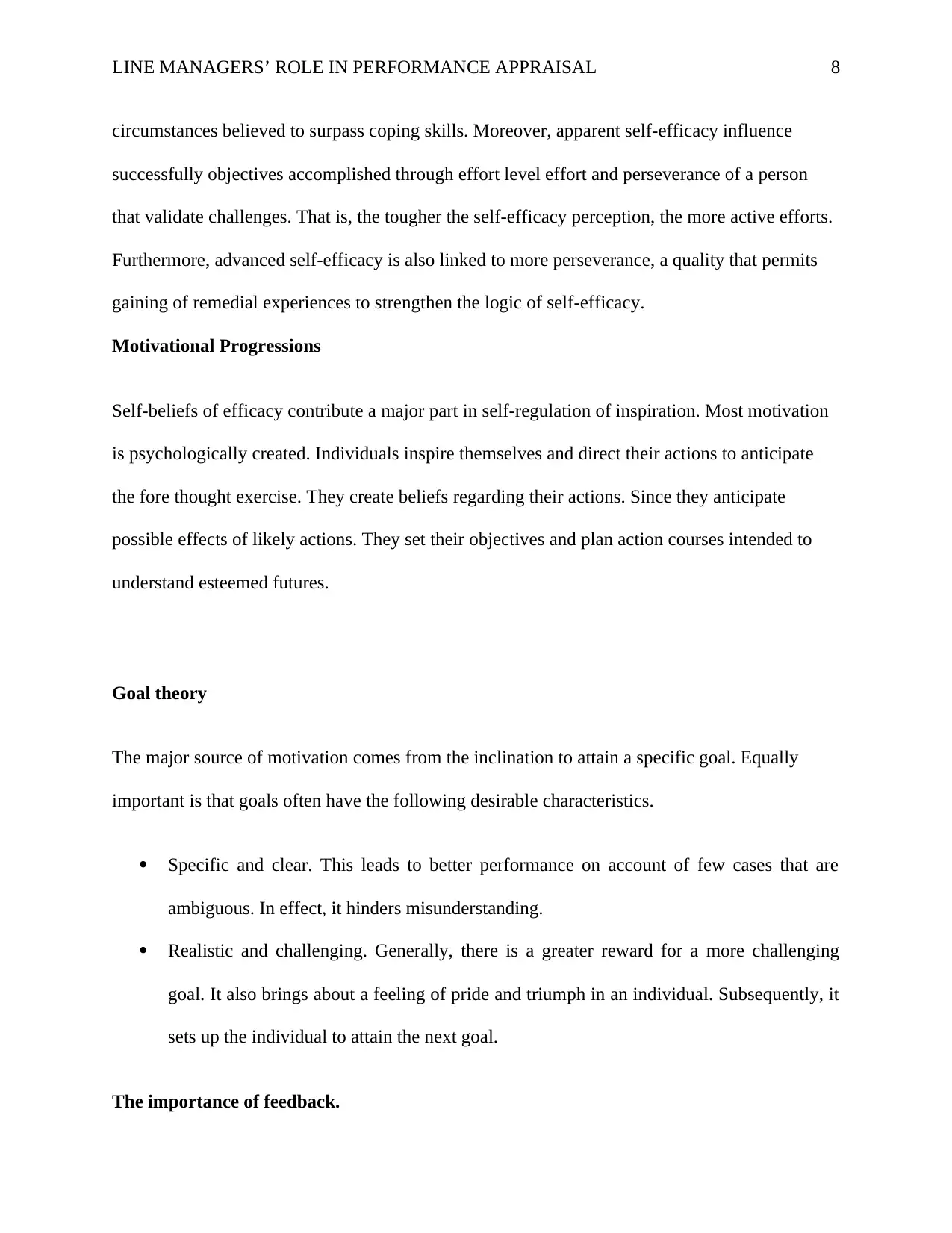
LINE MANAGERS’ ROLE IN PERFORMANCE APPRAISAL 8
circumstances believed to surpass coping skills. Moreover, apparent self-efficacy influence
successfully objectives accomplished through effort level effort and perseverance of a person
that validate challenges. That is, the tougher the self-efficacy perception, the more active efforts.
Furthermore, advanced self-efficacy is also linked to more perseverance, a quality that permits
gaining of remedial experiences to strengthen the logic of self-efficacy.
Motivational Progressions
Self-beliefs of efficacy contribute a major part in self-regulation of inspiration. Most motivation
is psychologically created. Individuals inspire themselves and direct their actions to anticipate
the fore thought exercise. They create beliefs regarding their actions. Since they anticipate
possible effects of likely actions. They set their objectives and plan action courses intended to
understand esteemed futures.
Goal theory
The major source of motivation comes from the inclination to attain a specific goal. Equally
important is that goals often have the following desirable characteristics.
Specific and clear. This leads to better performance on account of few cases that are
ambiguous. In effect, it hinders misunderstanding.
Realistic and challenging. Generally, there is a greater reward for a more challenging
goal. It also brings about a feeling of pride and triumph in an individual. Subsequently, it
sets up the individual to attain the next goal.
The importance of feedback.
circumstances believed to surpass coping skills. Moreover, apparent self-efficacy influence
successfully objectives accomplished through effort level effort and perseverance of a person
that validate challenges. That is, the tougher the self-efficacy perception, the more active efforts.
Furthermore, advanced self-efficacy is also linked to more perseverance, a quality that permits
gaining of remedial experiences to strengthen the logic of self-efficacy.
Motivational Progressions
Self-beliefs of efficacy contribute a major part in self-regulation of inspiration. Most motivation
is psychologically created. Individuals inspire themselves and direct their actions to anticipate
the fore thought exercise. They create beliefs regarding their actions. Since they anticipate
possible effects of likely actions. They set their objectives and plan action courses intended to
understand esteemed futures.
Goal theory
The major source of motivation comes from the inclination to attain a specific goal. Equally
important is that goals often have the following desirable characteristics.
Specific and clear. This leads to better performance on account of few cases that are
ambiguous. In effect, it hinders misunderstanding.
Realistic and challenging. Generally, there is a greater reward for a more challenging
goal. It also brings about a feeling of pride and triumph in an individual. Subsequently, it
sets up the individual to attain the next goal.
The importance of feedback.
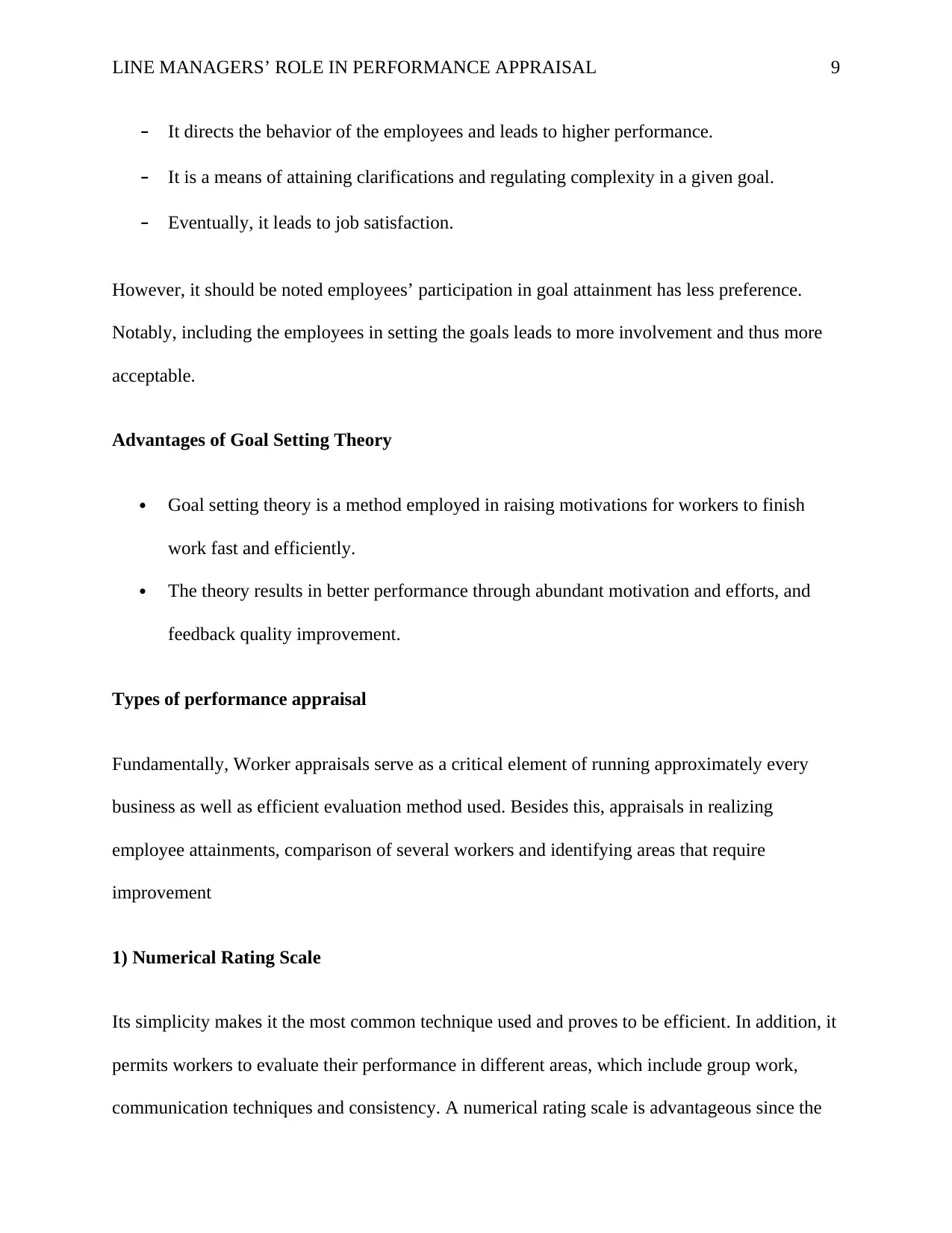
LINE MANAGERS’ ROLE IN PERFORMANCE APPRAISAL 9
– It directs the behavior of the employees and leads to higher performance.
– It is a means of attaining clarifications and regulating complexity in a given goal.
– Eventually, it leads to job satisfaction.
However, it should be noted employees’ participation in goal attainment has less preference.
Notably, including the employees in setting the goals leads to more involvement and thus more
acceptable.
Advantages of Goal Setting Theory
Goal setting theory is a method employed in raising motivations for workers to finish
work fast and efficiently.
The theory results in better performance through abundant motivation and efforts, and
feedback quality improvement.
Types of performance appraisal
Fundamentally, Worker appraisals serve as a critical element of running approximately every
business as well as efficient evaluation method used. Besides this, appraisals in realizing
employee attainments, comparison of several workers and identifying areas that require
improvement
1) Numerical Rating Scale
Its simplicity makes it the most common technique used and proves to be efficient. In addition, it
permits workers to evaluate their performance in different areas, which include group work,
communication techniques and consistency. A numerical rating scale is advantageous since the
– It directs the behavior of the employees and leads to higher performance.
– It is a means of attaining clarifications and regulating complexity in a given goal.
– Eventually, it leads to job satisfaction.
However, it should be noted employees’ participation in goal attainment has less preference.
Notably, including the employees in setting the goals leads to more involvement and thus more
acceptable.
Advantages of Goal Setting Theory
Goal setting theory is a method employed in raising motivations for workers to finish
work fast and efficiently.
The theory results in better performance through abundant motivation and efforts, and
feedback quality improvement.
Types of performance appraisal
Fundamentally, Worker appraisals serve as a critical element of running approximately every
business as well as efficient evaluation method used. Besides this, appraisals in realizing
employee attainments, comparison of several workers and identifying areas that require
improvement
1) Numerical Rating Scale
Its simplicity makes it the most common technique used and proves to be efficient. In addition, it
permits workers to evaluate their performance in different areas, which include group work,
communication techniques and consistency. A numerical rating scale is advantageous since the
⊘ This is a preview!⊘
Do you want full access?
Subscribe today to unlock all pages.

Trusted by 1+ million students worldwide
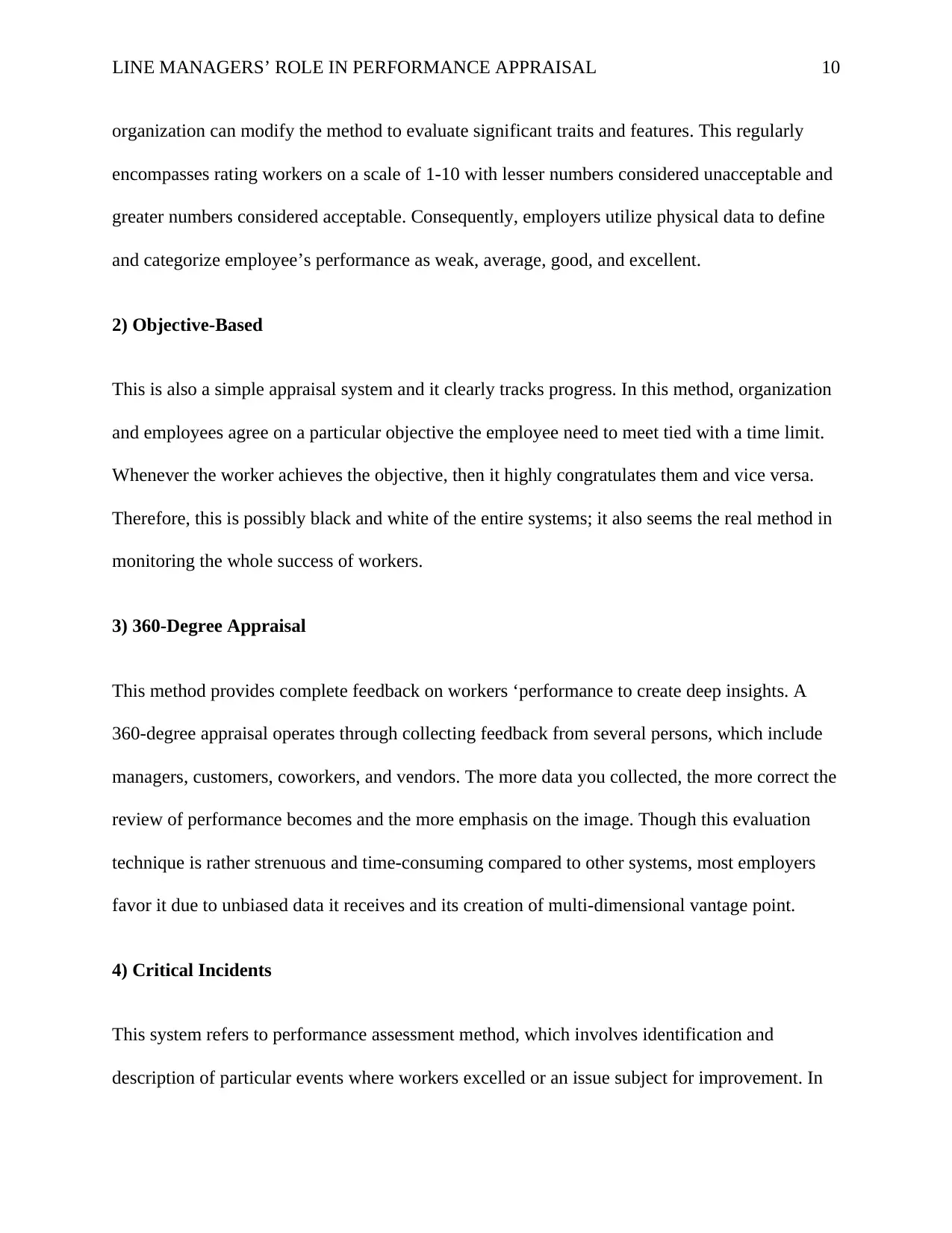
LINE MANAGERS’ ROLE IN PERFORMANCE APPRAISAL 10
organization can modify the method to evaluate significant traits and features. This regularly
encompasses rating workers on a scale of 1-10 with lesser numbers considered unacceptable and
greater numbers considered acceptable. Consequently, employers utilize physical data to define
and categorize employee’s performance as weak, average, good, and excellent.
2) Objective-Based
This is also a simple appraisal system and it clearly tracks progress. In this method, organization
and employees agree on a particular objective the employee need to meet tied with a time limit.
Whenever the worker achieves the objective, then it highly congratulates them and vice versa.
Therefore, this is possibly black and white of the entire systems; it also seems the real method in
monitoring the whole success of workers.
3) 360-Degree Appraisal
This method provides complete feedback on workers ‘performance to create deep insights. A
360-degree appraisal operates through collecting feedback from several persons, which include
managers, customers, coworkers, and vendors. The more data you collected, the more correct the
review of performance becomes and the more emphasis on the image. Though this evaluation
technique is rather strenuous and time-consuming compared to other systems, most employers
favor it due to unbiased data it receives and its creation of multi-dimensional vantage point.
4) Critical Incidents
This system refers to performance assessment method, which involves identification and
description of particular events where workers excelled or an issue subject for improvement. In
organization can modify the method to evaluate significant traits and features. This regularly
encompasses rating workers on a scale of 1-10 with lesser numbers considered unacceptable and
greater numbers considered acceptable. Consequently, employers utilize physical data to define
and categorize employee’s performance as weak, average, good, and excellent.
2) Objective-Based
This is also a simple appraisal system and it clearly tracks progress. In this method, organization
and employees agree on a particular objective the employee need to meet tied with a time limit.
Whenever the worker achieves the objective, then it highly congratulates them and vice versa.
Therefore, this is possibly black and white of the entire systems; it also seems the real method in
monitoring the whole success of workers.
3) 360-Degree Appraisal
This method provides complete feedback on workers ‘performance to create deep insights. A
360-degree appraisal operates through collecting feedback from several persons, which include
managers, customers, coworkers, and vendors. The more data you collected, the more correct the
review of performance becomes and the more emphasis on the image. Though this evaluation
technique is rather strenuous and time-consuming compared to other systems, most employers
favor it due to unbiased data it receives and its creation of multi-dimensional vantage point.
4) Critical Incidents
This system refers to performance assessment method, which involves identification and
description of particular events where workers excelled or an issue subject for improvement. In
Paraphrase This Document
Need a fresh take? Get an instant paraphrase of this document with our AI Paraphraser
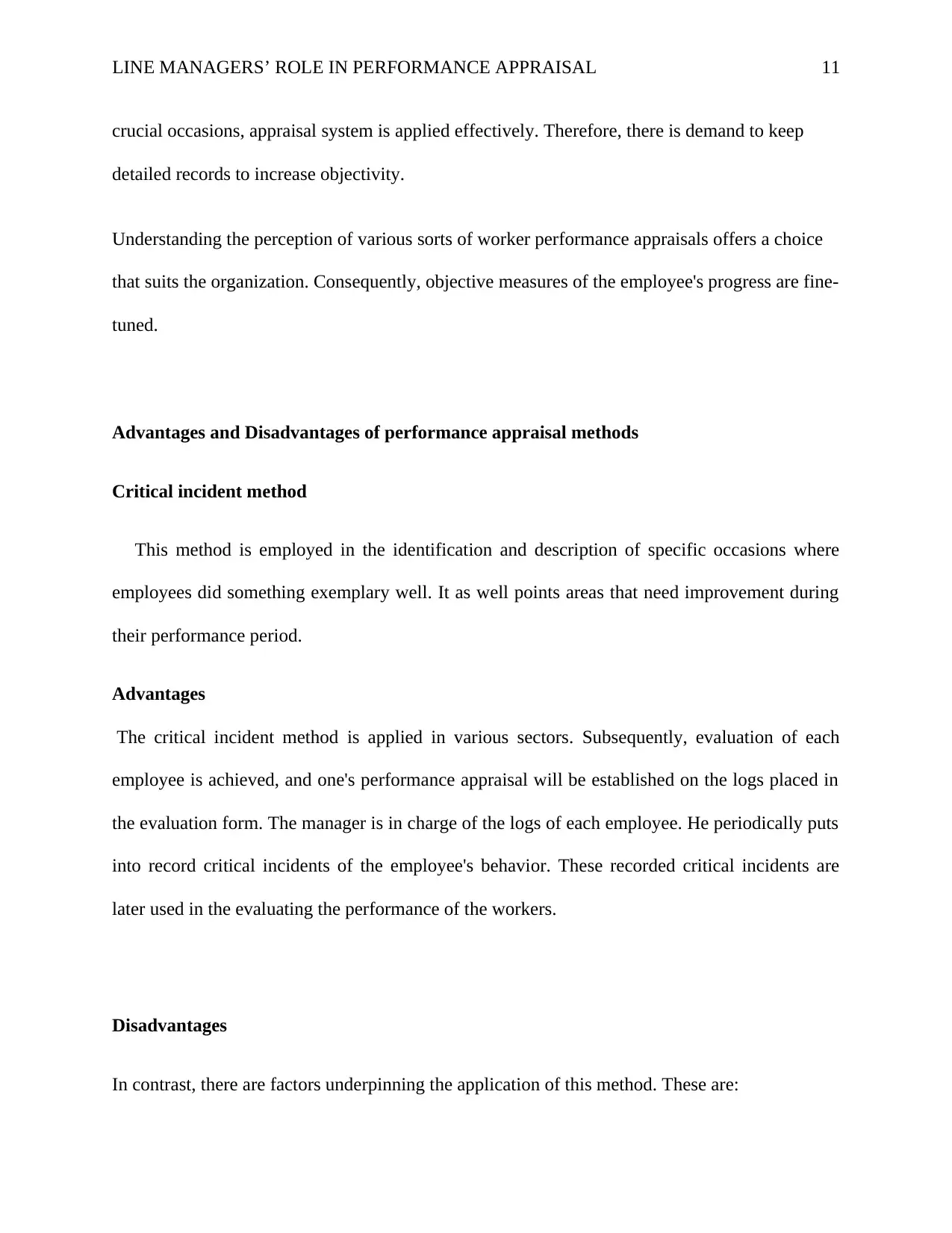
LINE MANAGERS’ ROLE IN PERFORMANCE APPRAISAL 11
crucial occasions, appraisal system is applied effectively. Therefore, there is demand to keep
detailed records to increase objectivity.
Understanding the perception of various sorts of worker performance appraisals offers a choice
that suits the organization. Consequently, objective measures of the employee's progress are fine-
tuned.
Advantages and Disadvantages of performance appraisal methods
Critical incident method
This method is employed in the identification and description of specific occasions where
employees did something exemplary well. It as well points areas that need improvement during
their performance period.
Advantages
The critical incident method is applied in various sectors. Subsequently, evaluation of each
employee is achieved, and one's performance appraisal will be established on the logs placed in
the evaluation form. The manager is in charge of the logs of each employee. He periodically puts
into record critical incidents of the employee's behavior. These recorded critical incidents are
later used in the evaluating the performance of the workers.
Disadvantages
In contrast, there are factors underpinning the application of this method. These are:
crucial occasions, appraisal system is applied effectively. Therefore, there is demand to keep
detailed records to increase objectivity.
Understanding the perception of various sorts of worker performance appraisals offers a choice
that suits the organization. Consequently, objective measures of the employee's progress are fine-
tuned.
Advantages and Disadvantages of performance appraisal methods
Critical incident method
This method is employed in the identification and description of specific occasions where
employees did something exemplary well. It as well points areas that need improvement during
their performance period.
Advantages
The critical incident method is applied in various sectors. Subsequently, evaluation of each
employee is achieved, and one's performance appraisal will be established on the logs placed in
the evaluation form. The manager is in charge of the logs of each employee. He periodically puts
into record critical incidents of the employee's behavior. These recorded critical incidents are
later used in the evaluating the performance of the workers.
Disadvantages
In contrast, there are factors underpinning the application of this method. These are:
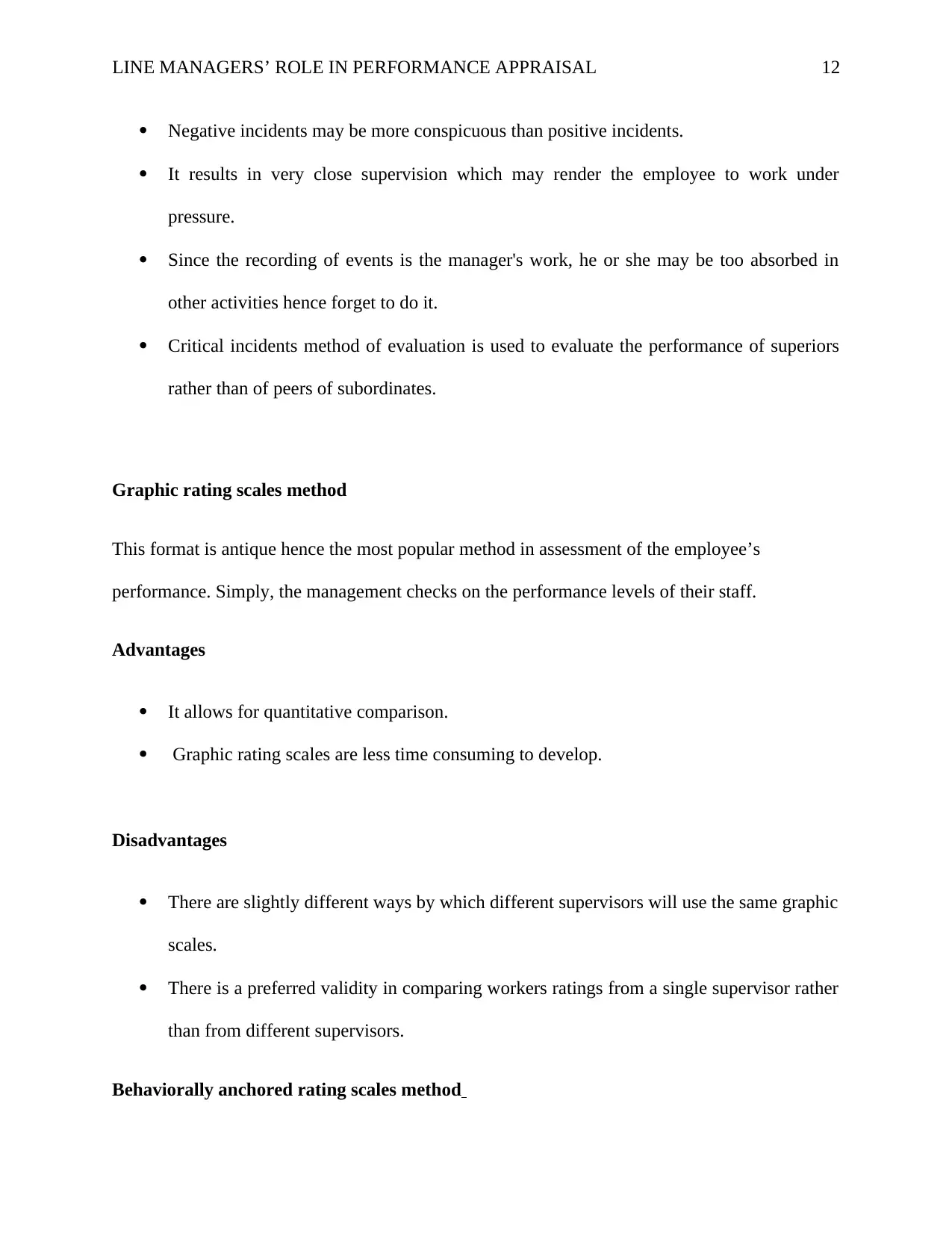
LINE MANAGERS’ ROLE IN PERFORMANCE APPRAISAL 12
Negative incidents may be more conspicuous than positive incidents.
It results in very close supervision which may render the employee to work under
pressure.
Since the recording of events is the manager's work, he or she may be too absorbed in
other activities hence forget to do it.
Critical incidents method of evaluation is used to evaluate the performance of superiors
rather than of peers of subordinates.
Graphic rating scales method
This format is antique hence the most popular method in assessment of the employee’s
performance. Simply, the management checks on the performance levels of their staff.
Advantages
It allows for quantitative comparison.
Graphic rating scales are less time consuming to develop.
Disadvantages
There are slightly different ways by which different supervisors will use the same graphic
scales.
There is a preferred validity in comparing workers ratings from a single supervisor rather
than from different supervisors.
Behaviorally anchored rating scales method
Negative incidents may be more conspicuous than positive incidents.
It results in very close supervision which may render the employee to work under
pressure.
Since the recording of events is the manager's work, he or she may be too absorbed in
other activities hence forget to do it.
Critical incidents method of evaluation is used to evaluate the performance of superiors
rather than of peers of subordinates.
Graphic rating scales method
This format is antique hence the most popular method in assessment of the employee’s
performance. Simply, the management checks on the performance levels of their staff.
Advantages
It allows for quantitative comparison.
Graphic rating scales are less time consuming to develop.
Disadvantages
There are slightly different ways by which different supervisors will use the same graphic
scales.
There is a preferred validity in comparing workers ratings from a single supervisor rather
than from different supervisors.
Behaviorally anchored rating scales method
⊘ This is a preview!⊘
Do you want full access?
Subscribe today to unlock all pages.

Trusted by 1+ million students worldwide
1 out of 27
Related Documents
Your All-in-One AI-Powered Toolkit for Academic Success.
+13062052269
info@desklib.com
Available 24*7 on WhatsApp / Email
![[object Object]](/_next/static/media/star-bottom.7253800d.svg)
Unlock your academic potential
Copyright © 2020–2025 A2Z Services. All Rights Reserved. Developed and managed by ZUCOL.




